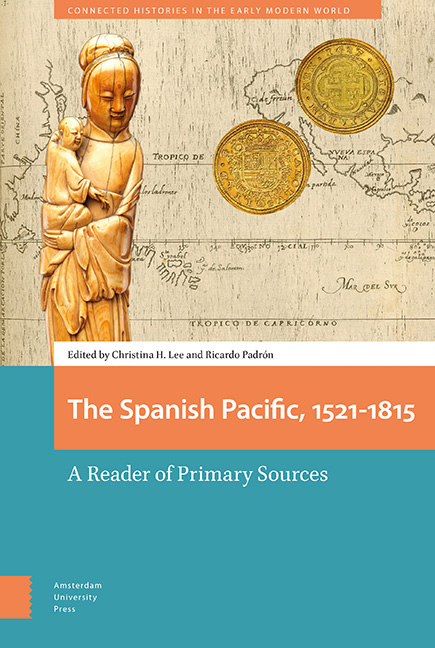Book contents
- Frontmatter
- Contents
- Abbreviations
- Acknowledgements
- Introduction
- 1 An Early Transpacific Account of the Spice Islands by Andrés de Urdaneta (1536)
- 2 Domingo de Salazar’s Letter to the King of Spain in Defense of the Indians and the Chinese of the Philippine Islands (1582)
- 3 Juan Cobo’s Map of the Pacific World (1593)
- 4 A Royal Decree of Philip III Regulating Trade between the Philippines and New Spain (1604)
- 5 Manila’s Sangleys and a Chinese Wedding (1625)
- 6 Don Luis Castilla Offers to Sell Land in Manila (1629)
- 7 Idolatry and Apostasy in the 1633 Jesuit Annual Letter
- 8 The Will of an Indian Oriental and her Chinos in Peru (1644
- 9 Francisco de Combés’s History of Mindanao and Jolo (1667)
- 10 Between Fiction and History in the Spanish Pacific The Misfortunes of Alonso Ramírez (1690)
- 11 A Moluccan Crypto-Muslim before the Transpacific Inquisition (1623–1645)
- 12 Constitutions and Rules of the Beatas Indias (1726)
- 13 The Poetics of Praise and the Demands of Confession in the Early Spanish Philippines: Notes and Documents
- 14 The Pacific Theater of the Seven Years’ War in a Latin Poem by an Indigenous Priest, Bartolomé Saguinsín (1766)
- 15 A Prohibition on Digging Up the Bones of the Dead (1813)
- Index
12 - Constitutions and Rules of the Beatas Indias (1726)
Published online by Cambridge University Press: 20 November 2020
- Frontmatter
- Contents
- Abbreviations
- Acknowledgements
- Introduction
- 1 An Early Transpacific Account of the Spice Islands by Andrés de Urdaneta (1536)
- 2 Domingo de Salazar’s Letter to the King of Spain in Defense of the Indians and the Chinese of the Philippine Islands (1582)
- 3 Juan Cobo’s Map of the Pacific World (1593)
- 4 A Royal Decree of Philip III Regulating Trade between the Philippines and New Spain (1604)
- 5 Manila’s Sangleys and a Chinese Wedding (1625)
- 6 Don Luis Castilla Offers to Sell Land in Manila (1629)
- 7 Idolatry and Apostasy in the 1633 Jesuit Annual Letter
- 8 The Will of an Indian Oriental and her Chinos in Peru (1644
- 9 Francisco de Combés’s History of Mindanao and Jolo (1667)
- 10 Between Fiction and History in the Spanish Pacific The Misfortunes of Alonso Ramírez (1690)
- 11 A Moluccan Crypto-Muslim before the Transpacific Inquisition (1623–1645)
- 12 Constitutions and Rules of the Beatas Indias (1726)
- 13 The Poetics of Praise and the Demands of Confession in the Early Spanish Philippines: Notes and Documents
- 14 The Pacific Theater of the Seven Years’ War in a Latin Poem by an Indigenous Priest, Bartolomé Saguinsín (1766)
- 15 A Prohibition on Digging Up the Bones of the Dead (1813)
- Index
Summary
Abstract
In 1726, a Chinese mestiza woman named Ignacia del Espiritu Santo (1663–1748) sought ecclesiastical approval for a beaterio, or house of religious retreat for women, that she had founded in Manila. It was the first such community intended for women of native, sangley and mestizo origin. With the help of unnamed Jesuit collaborators, she composed a constitution for the community, called La Compañia, outlining criteria for admission and a series of requirements meant to structure the community's life of prayer and austerity. Kathryn Santner places the text in the context of female religious life in colonial Manila.
Keywords: religion; women; colonial Manila; Jesuits; beatas
As the Catholic Church sought to establish itself in the Philippines, the mendicant religious orders founded numerous missions and monasteries for male ecclesiastics, but only one convent for women was ever established. The Real Monasterio de Santa Clara, was founded as a Franciscan convent in 1621, exactly a century after the arrival of the Spanish to the Philippines. The reluctance of ecclesiastical and royal authorities to grant licenses for new convents, as well as the restriction of membership to Spanish women, contributed to the dearth of these foundations in the Philippines. With little hope of joining a convent, Manila's women founded beaterios, lay houses of religious retreat whose members took only simple vows and did not live in claustration. Many such institutions also served as schools, teaching young girls Christian doctrine, sewing and embroidery, the basics of reading and writing, and other subjects suitable to their sex.
La Compañia, the foundation for which these Constitutions were written, was the first beaterio in the Philippines established explicitly for native women, Sangleys, and mestizas. It was founded through the efforts of Ignacia del Espiritu Santo (1663–1748), an indigenous-Chinese mestiza born in the predominantly Chinese parish of Binondo. Ignacia and other pious women began to congregate around the Jesuit Church in 1685 and receive instruction from the Jesuit fathers. Unlike other monastic orders, the Jesuit rules preclude the formal participation of women in religious life; though not officially members of the order, nor under Jesuit authority, the beatas still visited the church for mass daily and Jesuit priests served as their spiritual instructors.
- Type
- Chapter
- Information
- Spanish Pacific, 1521–1815A Reader of Primary Sources, pp. 189 - 204Publisher: Amsterdam University PressPrint publication year: 2020



